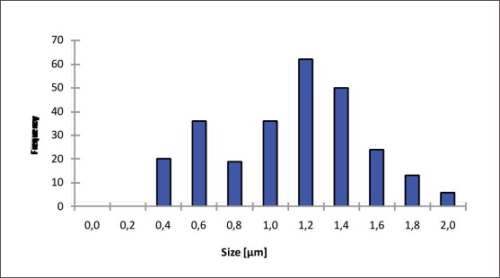
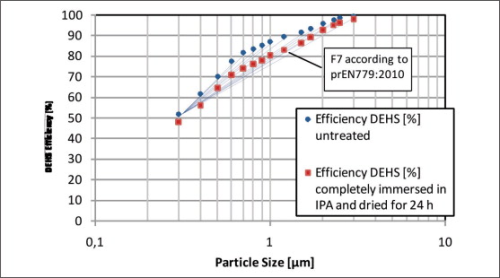
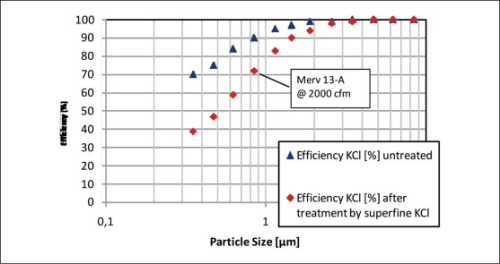
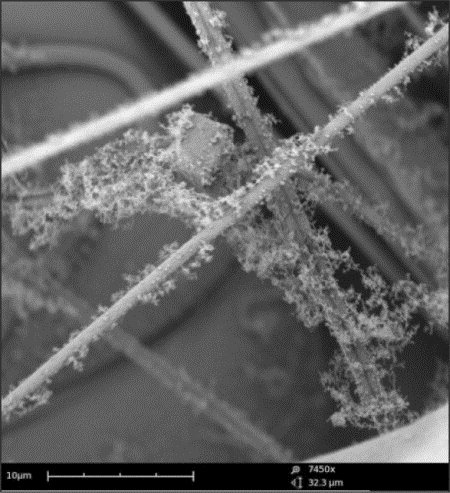
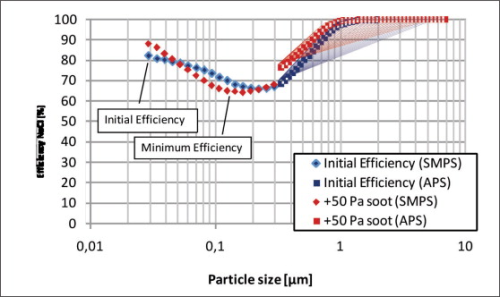
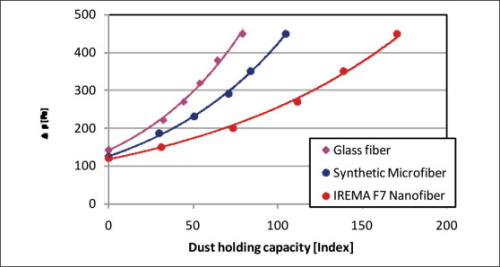
In air filtration the basic principles of particle deposition on filter media are known as screening, inertial impaction, direct interception and diffusion. In addition, using appropriate synthetic materials electrostatic attraction forces between particle and fibre surface can strongly enhance the capture of small particles (i.e. < 1 μm).
Although the effectiveness of these electret filter media has been sufficient in many applications, the legitimacy of its use is still questioned as the electret effect may decay in a non-predictable way under real life conditions. Cutting edge is the HVAC filtration industry, where the latest test standards for filter products consider and valuate a possible charge decay of electret filter media.
At the same time it has to be taken into account that electrostatic forces help to improve particle removal efficiency without increasing the pressure drop of the filter media. This meets one of today's most important requirements – a low energy demand during the use of air filter products.
It is obvious that the use of electrostatic forces can be a controversial subject. However, in this article it will be shown how the drawbacks of electret media can be overcome by a convenient filter media design using superfine fibres – additionally leading to better energy efficiency and longer lifetime. Two fields of applications will be discussed – HVAC filtration and vehicle air filtration.
In the filtration world, in particular for HVAC applications, the closer surveillance of lifetime filtration characteristics and efficiencies has become widely accepted and has found its way into the newest test procedures. In particular, the long term stability of electrostatic charges on the surface of synthetic fibres has been examined closely for decades, because under some circumstances the effectiveness of surface charges can drop over time.
HVAC filtration
The recent issues of the two most common test standards for HVAC filters, the Modified ASHRAE Standard 52.2 with Appendix J in the USA and the FprEN 779:2010 in Europe have included the investigation of the influence of electrostatic charges on filtration efficiencies. Different treatments are chosen to simulate discharge effects, charge decay effects or charge covering effects of real life operation. While ASHRAE favours a filter media treatment with superfine particles (sub 0.1 μm KCl aerosol), the European counterpart proposes the isopropyl alcohol treatment. Although the treatment method itself is still a topic of ongoing discussion, the basic idea of its use is now widely accepted, and manufacturers of synthetic filter media have to react to the higher mechanical filtration efficiencies claimed by the currents test standards.
Higher mechanical efficiencies can be achieved easily by media design with increased air flow resistance. However, this approach is not competitive, especially when taking energy consumption into account. In recent years, the advancements in efficient production of submicron fibres and nanofibres has led to new synthetic filter media combining improved mechanical and electrostatic forces for particle retention. At the same time the fine fibres make sure that the pressure drop of the filter media remains comparatively low.
Using its proprietary Integrated Nanofiber Technology, IREMA FILTER has developed new synthetic products for HVAC filtration. One type of media was tested in independent test laboratories (flat sheets and pleats) in order to directly compare the effects of different discharge methods:
- • Isopropyl alcohol (prEN779:2010)
• Superfine KCl (ASHRAE 52.2 Appendix J)
• Soot nanoparticles
In addition to EN779 and ASHRAE tests, soot nanoparticles were applied to the filter media because the discharge effect of soot was demonstrated in the ASHRAE Research Projects 1189 and 1190. This was investigated because soot particles are found worldwide in urban environments due to emissions of two- and four-wheeled vehicles powered by diesel engines [[2], [3] and [4]].
The filter media consists of polypropylene – a polymer that shows a distinct electret effect. The depth filter media design consists of multiple zones addressing different filter media requirements, such as pleatability, dust holding capacity, retention of fine particles, as well as nanofibre protection. The mechanical efficiency of the media mainly relies on an integrated fine fibre zone (see Figure 1).
Isopropyl alcohol treatment (prEN779:2010)
The material was pleated and tested independently for its influence of electrostatic forces. It was shown that applying the regular EN779:2002, which is a test without any discharge treatment, would result in an F7 grade filter.
EN779:2010 additionally claims a minimum DEHS efficiency of 35% for the smallest DEHS particles after IPA treatment, which was achieved by the new filter media as well.
After that the pleated filter was even discharged by complete immersion in isopropyl alcohol and tested again, after a drying period of 24 hours, according to EN 779. The strong impact of the nanofibres (down to a diameter of 0.4 microns) on the mechanical filter efficiency was evident. The efficiency drop of the completely discharged filter compared to a non-treated sample is marginal (see Figure 2). Both test versions (non-treated and treated) result in a filter class F7 at comparable pressure drops.
Superfine KCl treatment (ASHRAE 52.2 Appendix J) In contrast to the immersion technique of EN779, the ASHRAE discharge test favours a particle-based procedure. Superfine potassium chloride particles (about 40 nm in diameter) are loaded onto the pleated filter. At the same time, the efficiency of KCl removal (between 0.3 and 10 μm) is constantly tested until a minimum efficiency is reported. During this conditioning step no pressure drop increase is observed at all. Thereafter dust loading starts according to the usual ASHRAE 52.2 test standard to determine the respective Merv classification. Using this discharge method the filtration efficiency of the tested filter clearly drops for small particles. This shows that surface charges still existing on the fibres must have been inactivated by impinging KCl nanoparticles. However, applying the complete test procedure, the filter was rated as Merv 13-A. This means that Merv 13 (comparable to European F7) was reached in discharged condition (see Figure 3). Soot particles
In urban environments, where there are high traffic volumes of diesel engines or other combustion processes, significant quantities of soot nanoparticles and agglomerates are emitted to ambient air. At the same time soot particles – being conductive materials – are known to often have a strong influence on electrostatically charged air filters by removing the electret effect [3].
In order to investigate a second particle-based filter treatment in addition to the ASHRAE conditioning step, soot nanoparticles (mean diameter 70 nm) were generated and loaded onto the filter media. During loading the efficiency of NaCl removal was measured constantly. In contrast to the KCl nanoparticle loading, the pressure drop of the filter was constantly increasing as soot forms dentritic structures on the fibre surfaces (see Figure 4).
The soot particles did not lead at all to a loss of NaCl efficiency at particle sizes of 0.3 μm and above. Only at smaller particle sizes was a slight efficiency drop observed by means of an SMPS. The initial and minimum efficiency curves (at + 50 Pa) are shown in Figure 5.
Discussion of discharge procedures
The recent investigations and direct comparison of different discharge methods on a particular filter media were undertaken to determine the electrostatic characteristics of IREMA FILTER synthetic fine dust media with integrated nanofibres.
Treatment by isopropyl alcohol (IPA) immersion did not significantly influence the DEHS removal from an airstream, as required in the newest test standard prEN779:2010. The test procedure was easy to use and results were reproducible for flat sheet materials as well as pleated filters in different heights.
Using the ASHRAE 52.2 Appendix J test procedure, surface charges were detected as KCl efficiency was initially higher and dropped during the discharge procedure. The minimum efficiency of KCl removal after conditioning was slightly lower than that of DEHS removal after IPA treatment, but in a close overall range. The ASHRAE test procedure was reproducible in different filter heights, but difficult to carry out, since the laboratory equipment required for the creation and characterisation of the conditioning aerosol is rare. Additionally, the conditioning of complete filters can take days to complete and therefore is cost-intensive. Also, the variability of this conditioning step in different US laboratories, even for non-electret media, would seem to be high [1].
Soot nanoparticles emitted by combustion processes did not practically lead to an efficiency drop for NaCl particles. During loading a fairly quick increase in pressure drop was measured due to the formation of dentritic structures, also enhancing the filtration efficiency.
It was shown that when using polypropylene filter media (which always shows at least inherent surface charges on the fibres) by applying nanofibres, the influence of surface charges and the electret effect can be reduced to a minimum. This means that synthetic filter materials are able to offer the same mechanical efficiencies as glass fibre media, including the advantages of synthetic materials that include higher mechanical stability, moisture resistance or a binder-free design and combustibility.
Energy efficiency
Higher mechanical filtration efficiencies, and not changing the media design, usually result in an increase in air flow resistance and a decrease in dust holding capacity. Naturally, there is a negative impact on energy efficiency.
When using fine fibres and nanofibres in order to achieve high mechanical filtration efficiency, the pressure drop increase of the filter media is comparably low. At the same time, with a beneficial arrangement, the different fibre diameters optimise the progressive design of the filter media and clearly enhance dust holding capacities. The IREMA fine dust filter media consists of an extremely progressive composition in order to provide an even longer lifetime at high mechanical efficiencies compared to conventional fine dust filter media. The results of a dust loading procedure of a pleated filter, according to the EN779 standard, are shown in Figure 6.
Starting at the same initial pressure drops, the IREMA FILTER nanofibre media can hold up to twice as much dust as conventional glass fibre or synthetic filters. By maintaining a low pressure drop over a long period of time results in significant energy savings being achieved. For an estimation of the energy demand of a pleated filter the following formula can be used: where
E = Energy demand [kWh]
Q = Flow rate [m3 s−1]
Δp = Pressure drop [Pa]
t = Time [h]
η = Fan efficiency
Typical assumptions:
Dust concentration: 1 g Ashrae/day
Flow rate: 3400 m3 s−1
Energy costs: 0.15 €/kWh
Cost per filter: 60 €/filter
Labour costs: 15 €/change
Under these assumptions, the annual energy savings of the IREMA FILTER nanofibre media compared to the conventional synthetic microfibre media is around 14%. Additional savings in labour costs lead to a total annual cost saving of about 20%.
Conclusions
The electret effect is often used to provide synthetic filter media with high initial efficiencies at low pressure drops, which is very favourable to run filters with low energy consumption. However, because higher mechanical filtration efficiencies are now also needed after discharge procedures, many synthetic filter media cannot meet both requirements, ie: providing high mechanical efficiency with long life.
IREMA FILTER has used two approaches to meet these requirements:
- • Using integrated nanofibres to achieve high mechanical efficiencies.
• Providing an extremely progressive media design to achieve higher dust holding capacities.
This permits the combination of high mechanical filtration efficiency and low energy consumption.
References
1 M. Britt, Variability of ANSI/ASHRAE 52.2, Air Media Magazine, 12, Fall 2008.
2 J.T. Hanley, M.K. Owen, Development of a New Conditioning Aerosol for Testing Electret Filters. ASHRAE Transactions: Symposia, 1190-RP, 1115, 2005.
3 M. Lehtimäki, Development of Test Methods for Electret Filter, Nordtest, NT Technical Report 320, NT Project 1164-94, 1996.
4 M. Lehtimäki, A. Säämänen, A. Taipale, Investigation of Mechanisms and Operating Environments that Impact the Filtration Efficiency of Charged Air Filtration Media (1189-TRP), VTT Technical Research Center of Finland, 2002/2005.
Contact: Dr. Andreas Seeberger IREMA FILTER GmbH An der Heide 16 92353 Postbauer-Pavelsbach Germany Tel: +49 9180 9414 0 E-mail: andreas.seeberger@irema.de www.irema.de






